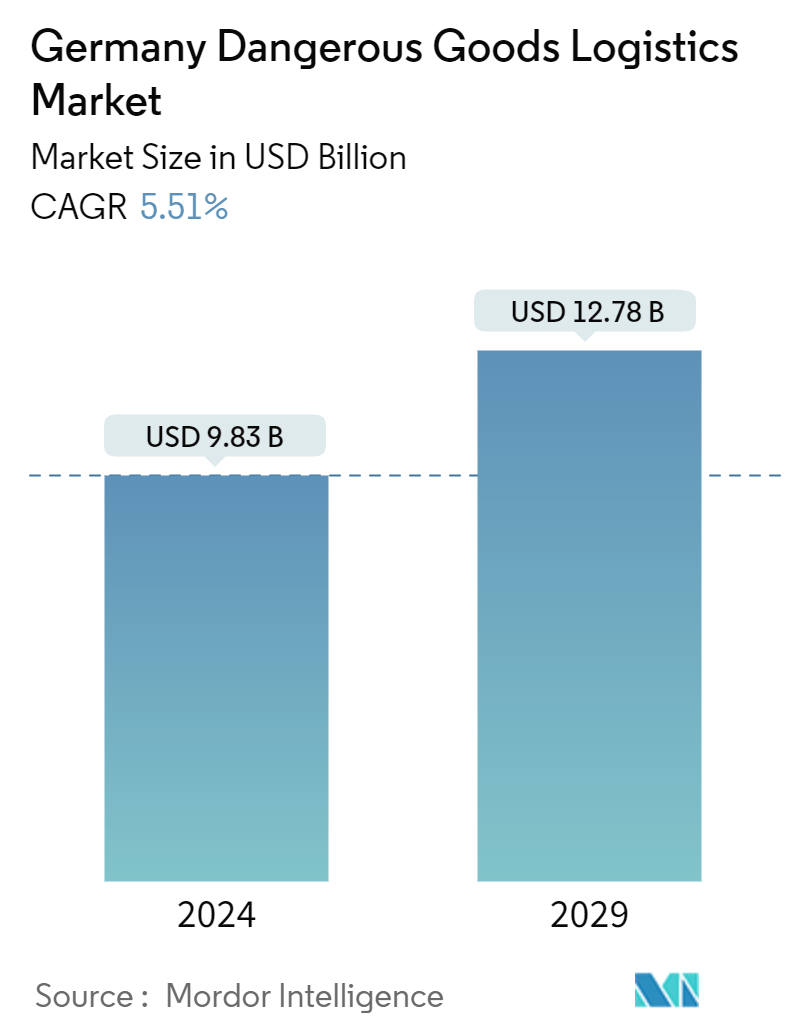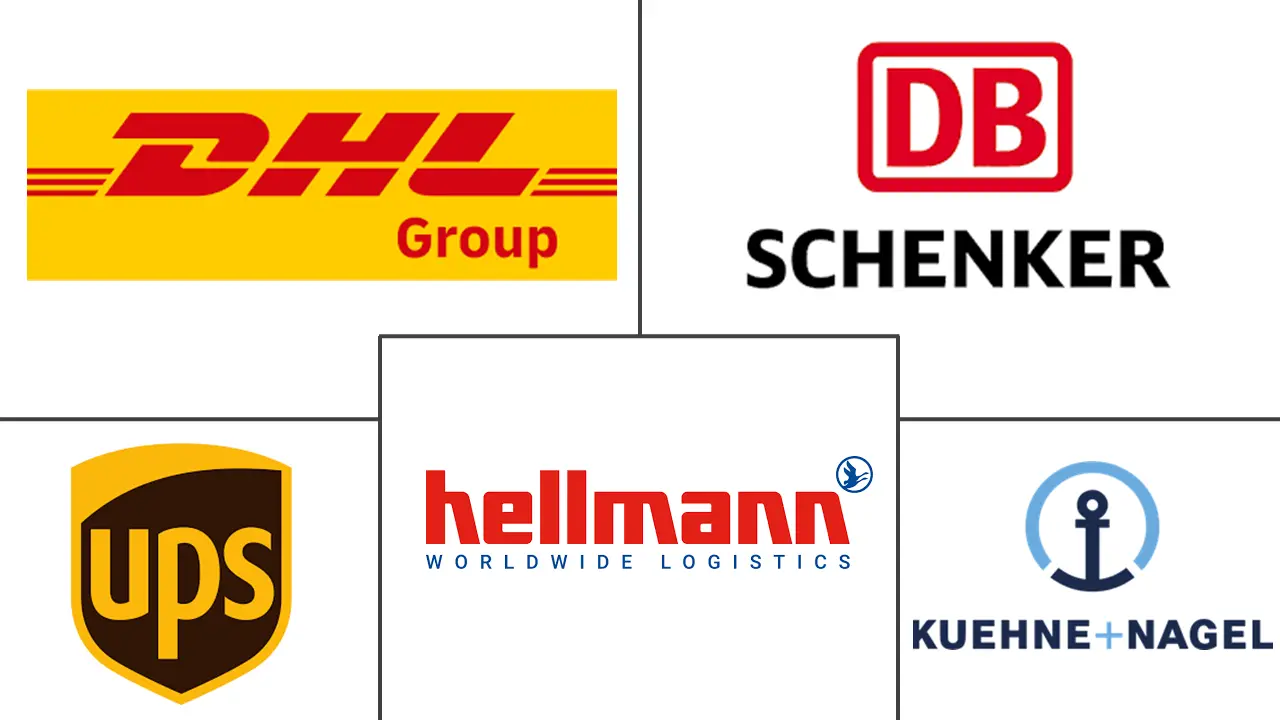Market Size of Germany Dangerous Goods Logistics Industry

| Study Period | 2020-2029 |
| Base Year For Estimation | 2023 |
| Market Size (2024) | USD 9.83 Billion |
| Market Size (2029) | USD 12.78 Billion |
| CAGR (2024 - 2029) | 5.51 % |
| Market Concentration | Low |
Major Players
*Disclaimer: Major Players sorted in no particular order |
Germany Dangerous Goods Logistics Market Analysis
The Germany Dangerous Goods Logistics Market size is estimated at USD 9.83 billion in 2024, and is expected to reach USD 12.78 billion by 2029, growing at a CAGR of 5.51% during the forecast period (2024-2029).
Germany has a well-developed and highly regulated logistics market for dangerous goods. It plays a crucial role in ensuring the safe transportation, handling, and storage of hazardous materials within the country and across borders.
In Germany, pharmaceuticals and new fine and specialty chemicals are the main focus. The dangerous goods logistics market in Germany accounts for nearly a fifth of the European market.
In Germany, the Energiewende is the process of transitioning from a hydrocarbon and nuclear-dominated economy to a low-carbon and nuclear-free economy based on renewable energy sources.
Germany has set a target of 80% of its energy supply coming from renewable sources by 2030. The 2% reduction in greenhouse gas emissions across all industrial sectors in 2022 was not enough to reach the country's 2030 climate target of reducing emissions by 55% from 1990.
The Russian energy crisis caused by the war in Ukraine increased the use of dirty coal electricity. Germany missed its 2022 GHG reduction targets for both the transportation sector and the real estate sector. To reach its 2030 target, Germany would need to triple its annual GHG reduction from 2% to 6% from 2023.
Germany relies heavily on oil and gas for electricity supply, and imports almost all of its energy. This dependency has created two sources of instability: first, global price movements have a significant impact on Germany's energy imports and end users, and second, market trends are heavily influenced by Germany's relations with some countries.
At the same time, the planned phase-out of nuclear and coal power will increase the country's reliance on gas, so it is becoming increasingly important to diversify its gas supply, including by importing more LNG.
Germany's share of electricity generated from renewable energy fed into its grid has been steadily increasing, and there have not been any notable incidents of power outages. This means that both commercial and private customers can count on a reliable and consistent energy supply, as Germany has among the lowest power outage rates in the world.
Germany Dangerous Goods Logistics Industry Segmentation
The dangerous goods logistics market refers to the transportation, handling, and storage of goods that are classified as hazardous goods or dangerous goods. This includes substances like chemicals, flammable materials, and explosives.
The German dangerous goods logistics market is segmented by service (transportation, warehousing and distribution, and value-added services) and destination (domestic and international). The report offers market size and forecasts for the German dangerous goods logistics market in value (USD) for all the above segments.
| By Service | |
| Transportation | |
| Warehousing and Distribution | |
| Value-added services |
| By Destination | |
| Domestic | |
| International |
Germany Dangerous Goods Logistics Market Size Summary
The Germany Dangerous Goods Logistics Market is a vital component of the country's logistics sector, characterized by its robust regulatory framework and focus on the safe transportation, handling, and storage of hazardous materials. This market is particularly significant within the European context, accounting for a substantial portion of the region's market share. The sector is heavily influenced by Germany's industrial activities, with pharmaceuticals and specialty chemicals being key areas of focus. The ongoing transition towards a low-carbon economy, as part of Germany's Energiewende initiative, is also shaping the logistics landscape, as the country aims to increase its reliance on renewable energy sources while managing the complexities of energy imports and geopolitical relations.
The competitive landscape of the German dangerous goods logistics market is marked by the presence of major players such as DHL, DB Schenker, Kuehne + Nagel, Hellmann Worldwide Logistics, and UPS. Recent strategic moves, such as JS Logistics' acquisition of ASTRE DACH and Scan Global Logistics' partnership with ETS transport & logistics GmbH, highlight the dynamic nature of the market, with companies seeking to enhance their regional presence and operational capabilities. These developments underscore the market's growth potential, driven by both domestic and international demand for specialized logistics services in handling dangerous goods.
Germany Dangerous Goods Logistics Market Size - Table of Contents
-
1. MARKET INSIGHTS
-
1.1 Market Overview
-
1.2 Current Market Scenario
-
1.3 Technological Trends in the Industry
-
1.4 Government Initiatives and Regulations
-
1.5 Insights into the Ecommerce
-
1.6 Value Chain/Supply Chain Analysis
-
1.7 Demand and Supply Analysis
-
1.8 Impact of COVID-19 on the Market
-
-
2. MARKET SEGMENTATION
-
2.1 By Service
-
2.1.1 Transportation
-
2.1.2 Warehousing and Distribution
-
2.1.3 Value-added services
-
-
2.2 By Destination
-
2.2.1 Domestic
-
2.2.2 International
-
-
Germany Dangerous Goods Logistics Market Size FAQs
How big is the Germany Dangerous Goods Logistics Market?
The Germany Dangerous Goods Logistics Market size is expected to reach USD 9.83 billion in 2024 and grow at a CAGR of 5.51% to reach USD 12.78 billion by 2029.
What is the current Germany Dangerous Goods Logistics Market size?
In 2024, the Germany Dangerous Goods Logistics Market size is expected to reach USD 9.83 billion.

